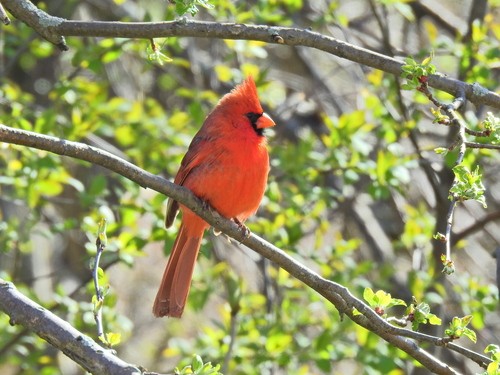Northern Cardinal
A species of Typical Cardinals, Also known as Cardinal Grosbeak, Red Cardinal Scientific name : Cardinalis cardinalis Genus : Typical Cardinals
Northern Cardinal, A species of Typical Cardinals
Also known as:
Cardinal Grosbeak, Red Cardinal
Botanical name: Cardinalis cardinalis
Genus: Typical Cardinals
Description
The northern Cardinal is a distinctive, medium-sized songbird that inhabits temperate forests and yards. Its name is derived from the male's brilliant red plumage color which resembles red-robed Roman Catholic cardinals, while its crest looks like a bishop's mitre. Compared to the male, the female is much duller in color. The highly territorial males can be quite aggressive. Quite popular, this is the state bird of seven U.S. states.
Size
21 - 24 cm
Colors
Red
Bronze
Life Expectancy
15 years
Nest Placement
Shrub
Clutch Size
2 - 5 eggs
Incubation Period
1 - 2 broods
Number of Broods
11 - 13 days
Nestling Period
7 - 13 days
Feeding Habits
Northern Cardinal predominantly eats seeds, fruits, and insects. Diet includes dogwood, wild grape, buckwheat, various berries, corn, and especially black oil sunflower seed. They hop on the ground for food and feed young primarily insects, like beetles, crickets, and cicadas.
Habitat
Northern Cardinal prefers habitats with dense shrubbery ideal for nesting and perching, such as woodland and forest edges, overgrown fields, and shrublands. They are well-adapted to human-altered landscapes, including suburban and urban areas with ornamental vegetation. Wetlands, particularly marshy thickets, are also within their habitat range, as they exploit environments resulting from urban expansion.
Nest Behavior
About a week before construction, pairs assess potential sites. The female builds the nest using twigs, leaves, grapevine bark, and grasses, over 3-9 days. Northern Cardinal typically lay eggs once the nest is ready, and both parents participate in the care of the eggs and young, though they usually don't reuse nests.
Nest Characteristics
Northern Cardinal's nests are often located in forks of small branches in saplings, shrubs, or vines, 1-15 feet high, surrounded by dense foliage. Common trees and shrubs used include dogwood, honeysuckle, and others. Nests have four layers, with the dimensions of about 2-3 inches in height, an outer diameter of 4 inches, and an inner diameter of 3 inches.
Dite type
Granivorous
People often ask
Migration Overview
Northern Cardinal is a resident bird and doesn't migrate, basically settling in the southeastern United States. In recent years, however, there have been reports of its distribution spreading northward, even reaching Canada.
General Info
Feeding Habits
Bird food type

Black Oil Sunflower Seeds

Hulled Sunflower Seeds

Safflower

Cracked Corn

Peanut Hearts

Millet

Milo
Bird Feeder Type

Large Tube Feeder

Large Hopper

Platform

Ground
Sounds
Call
Recording location: United States
Song
Recording location: United States
Song
Recording location: United States
Song
Recording location: United States
Behavior
Northern Cardinal exhibit a notable behavior of movement, often hopping through low branches and foraging in pairs close to the ground. Their daily activities encompass singing and preening from elevated positions within shrubs. The expressive crest of northern Cardinal is a significant behavior indicator, raised when agitated and flattened during periods of calm. In non-breeding seasons, northern Cardinal can be observed in larger flocks, ranging from a dozen to several dozens, wherein a hierarchical forage structure is apparent with juveniles and females deferring to adult males. Northern Cardinal exhibit occasional mixed-species foraging behavior and demonstrate a preference for short flight patterns, signaling an adaptation to dense habitats. Furthermore, pair bonds may last over winter, though a fraction may dissolve before the subsequent breeding season.
Distribution Area
Northern Cardinal is numerous across the eastern United States from the southern half of Maine to Minnesota to the Texas-Mexico border and in Canada in the southern portions of Ontario, Quebec, New Brunswick and Nova Scotia, all the way east to Cape Breton Island. Its range also extends south through Mexico to the Isthmus of Tehuantepec, northern Guatemala, and northern Belize. 
Species Status
Not globally threatened.
Scientific Classification
Phylum
Chordates Class
Birds Order
Perching birds Family
Cardinals Genus
Typical Cardinals Species
Northern Cardinal 